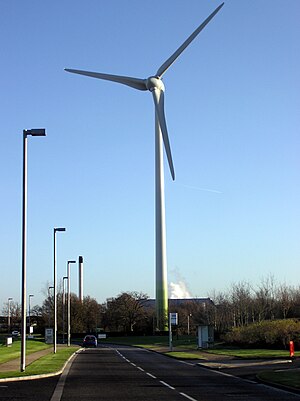 Image via Wikipedia
Image via WikipediaAlthough wind turbine blades are largely made of non-conductive plastics and similar composite materials, they are large constructions and the latest designs contain metal reinforcements and conductors for lightning protection. A single turbine therefore presents a significant but very geometrically variable ‘radar cross section’ that has the potential to reflect or diffract radio propagation waves, and cause a delayed multipath component that may interfere with the original radio link signal, says the group. The more windmill stock a farm has, the more unpredictable the reflections and diffractions of radio waves become, with potentially a far greater impact than may otherwise be expected.
The potential for interference is of particular concern for the utilities industry, which makes quite extensive use of scanning telemetry systems and SCADA (System Control and Data Acquisition) systems to monitor and control its infrastructure. These systems are often ‘fail-safe’ so that operations are automatically suspended if, for example, the SCADA system fails. Thus interference from wind turbines could potentially result in the shut-down of power and water supplies if serious interference is detected.A number of Analysys Mason consultants who are involved with the utilities industry are becomingly increasingly concerned about the vulnerability of one particular link type, mainly because of a lack of understanding and a lack of relevant research within the telecoms industry. The link type in question is that operating at around 460MHz, which is often used for telemetry or other SCADA applications. Within these applications the 460MHz band is often selected for particular links because the link path profile is non-line of sight, and this band permits the deployment of a diffracted path route between each link end as a design parameter. In these cases the link path loss is significantly greater than the nominal free-path loss that would otherwise exist for the line-of-sight case, and different interference design rules must be applied (as discussed below).
Across the UK, there are a number of radio links at 460MHz where the path profile relies on a terrain-diffracted path, rather than direct line of sight. From a system design perspective this is often why the comparatively low frequency of 460MHz has been selected, as it enables the use of a diffracted path, and
the impact of wind turbines and farms needs more field measurements and study to quantify the interference mechanisms, particularly in situations where the basic path is diffracted.
There is a sell of course - at Analysys Mason they have been studying all the publicly available material on wind turbine interference to radio propagation and have developed user-friendly computer models to evaluate and predict appropriate clearance zones around single and multiple wind turbines.
For more information, please contact Adrian Dain, Lead Consultant (adrian.dain@analysysmason.com) or John Wittams, Lead Consultant (john.wittams@analysysmason.com)

![Reblog this post [with Zemanta]](http://img.zemanta.com/reblog_e.png?x-id=a37f48cd-1661-4ae7-a6bc-56fb5d712232)
No comments:
Post a Comment